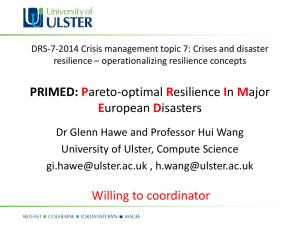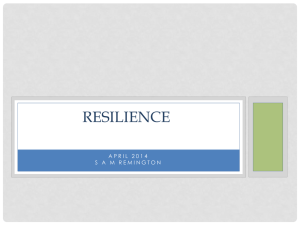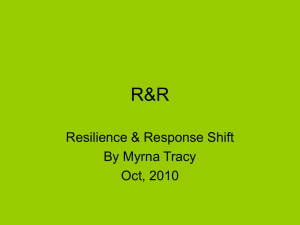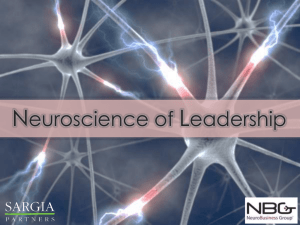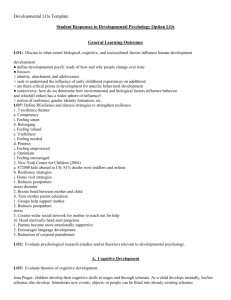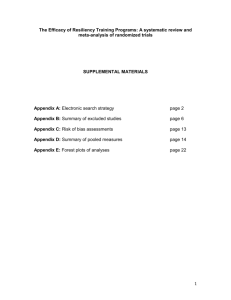Teen Self Esteem - Sha Tin College
advertisement
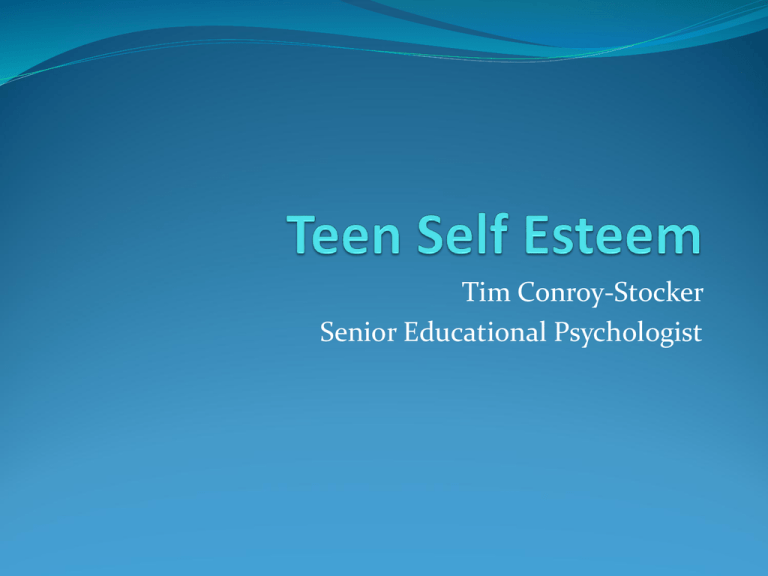
Tim Conroy-Stocker Senior Educational Psychologist What do we mean by self and self esteem? Who am I? Think about responses to the question ‘Who am I?’ Who am I? Physical Self Social Self Spiritual self Now what about the question ‘ Who do I want to be?’ Self Concept Self-concept Self-image Self-esteem Ideal-self The way we see ourselves The value we put on ourselves The way we would like to be From Lawrence (1996) ‘Enhancing Self Esteem in the Classroom’ Multiple self esteems Academic Social Physical Technological? Artistic? Factors affecting teen self esteem? The views of others Cooley ‘The looking Glass Self’ Multiple self esteems? Social identity Psychosocial stages The desire to be aware of trends! The pressure to succeed Resilience Mastery Relationships Emotional Reactivity ‘Our picture of ourselves is not derived by sitting in isolation but is generated by our engagement with others.’ Bannister and Fransella (1980) ‘The Psychology of Personal Constructs’ Erikson’s stages Age Virtues Psycho Social Crisis Significant Relationship Existential Question infant -18 months Hopes Trust vs. Mistrust Mother Can I Trust The Feeding, World? Abandonment 18 month-3 years Will Autonomy vs. Shame & Doubt Parents Is It Ok To Be Me? Toilet Training, Clothing Themselves Purpose Initiative vs. Guilt Family Is It Ok For Me To Do, Move and Act? Exploring, Using Tools or Making Art Neighbors, School Can I Make It In The World Of People And Things? School, Sports Who Am I? What Can I Be? Social Relationships 3-5 years 5-13 years 13-21years Competence Industry vs. Inferiority Fidelity Identity vs. Peers, Role Role Confusion Model Examples Identity vs. Role Confusion (Adolescence, 13 to 21 years) The adolescent is newly concerned with how they appear to others. As they make the transition from childhood to adulthood, adolescents ponder the roles they will play in the adult world. Initially, they are apt to experience some role confusion- mixed ideas and feelings about the specific ways in which they will fit into society- and may experiment with a variety of behaviors and activities (e.g. tinkering with cars, baby-sitting for neighbors, affiliating with certain political or religious groups). Eventually, Erikson proposed, most adolescents achieve a sense of identity regarding who they are and where their lives are headed. Identity vs. Role Confusion (Adolescence, 13 to 21 years) Adolescents "are confronted by the need to re-establish [boundaries] for themselves and to do this in the face of an often potentially hostile world. "This is often challenging since commitments are being asked for before particular identity roles have formed. At this point, one is in a state of 'identity confusion‘ No matter how one has been raised, one’s personal ideologies are now chosen for oneself. Oftentimes, this leads to conflict with adults over religious and political orientations. Another area where teenagers are deciding for themselves is their career choice, and oftentimes parents want to have a decisive say in that role. If this is too insistent, the teenager will acquiesce to external wishes, effectively forcing him or her to ‘foreclose’ on experimentation and, therefore, true self-discovery. Identity vs. Role Confusion (Adolescence, 13 to 21 years) Erikson does note that the time of Identity crisis for persons of genius is frequently prolonged. He further notes that in our industrial society, identity formation tends to be long, because it takes us so long to gain the skills needed for adulthood’s tasks in our technological world. So… we do not have an exact time span in which to find ourselves. It doesn't happen automatically at eighteen or at twenty-one. A very approximate rule of thumb for our society would put the end somewhere in one's twenties It was different in my day Everything that's already in the world when you're born is just normal. Anything created between birth and the age of 30 is incredibly exciting and creative and with any luck you can make a career out of it. But whatever is invented after you've turned 30 is against the natural order of things and is the beginning of the end of civilisation as we know it until it's been around for about 10 years, when it gradually turns out to be all right really. Douglas Adams (1999) Do you suffer from Trendfear? Do you ever get a nagging fear that trends are passing you by? What is Pinterest? And is it important what it is? And will Summly have a big year in 2012? And does that matter? If you're a school Principal and you don't understand the implications of the rise of location-based websites and apps like Foursquare, you might one day regret it. How much dual screening do you get involved in? Do your children suffer from Trendfear? Combine this with the focus on the role of others in shaping your identity. From peers the need to be aware of the: Latest music Latest games on iphone/android/ PS3/ xbox360/Wii Latest books/movies What hairstyle/weight/ exercise regime Which social groups are popular in school and what do they think/believe in. Subjects to choose at GCSE/post 16 The pressure to succeed I’m Stressed Where does the pressure come from? Aspiration Internalised parent Fear of failure Negative or positive goal state Resilience: Mastery and control How optimistic is the young person? How self efficacious do they feel? How adaptable are they Resilience: Relationships What degree of trust do they have in others? How supported do they feel by those around them? What degree of comfort can they take from the support of others? How tolerant are they of those around them? Resilience: Emotional Reactivity How sensitive are they to being upset/ receiving criticism? How quickly do they recover from being upset? How clear is their thinking when they are upset? Can they laugh at themselves? Can they roll with the punches? Resilience The more mastery they feel and feeling very related to others gives students lots of resources and makes them more resilient. If they are highly emotionally reactive and have low levels of resources then they will be more vulnerable and less resilient Motivating and helping teenagers Motivating and helping teenagers: Fostering resilience Tell them to work harder! Working backwards in steps from a goal state Exception finding with negative or low mood states Scaling questions to identify preferred futures and next steps. Healthy food Good amount of sleep Good Mental health ‘5 a day’ Anxiety and depression Help students to recognise the physical signs of anxiety Help them to reframe negative thoughts Don’t accept catastrophic self statements! Break down overwhelming tasks for them Normalise anxiety and stress The good news! Most teenagers with support from their parents, peers and teachers navigate adolescence effectively! There are lots of things we can do to foster resilience in children and young people Teenage anxiety and stress is not a new thing! New technology provides new areas of support as well as stress!





